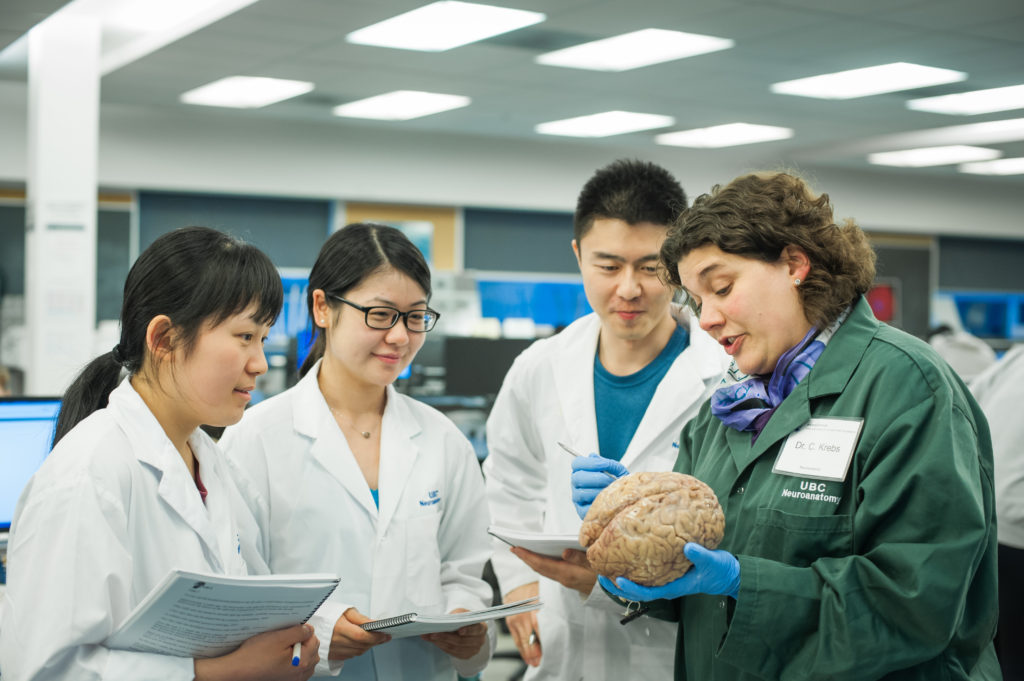From the vast network of blood vessels responsible for supplying blood to the brain to the tiny tendons of our toes, human anatomy is complex. And for hundreds of UBC students, it’s their job to master it all.
“It’s about so much more than learning the names of tendons and nerves, it’s about understanding how all of our systems intersect and shape who we are as humans,” says Kamyar Taheri, a UBC medical student.
Conquering such vast amounts of information is no easy feat, but today — thanks to a rich reserve of resources — the landscape of anatomy education at UBC is unrivalled.
“As we embark on the next century, we have a real opportunity to rethink and transform the way we educate — to extend our reach beyond the walls of the classroom and enrich the experience for everyone,” says Dr. Claudia Krebs, a professor of anatomy in UBC’s faculty of medicine.
With support from UBC’s Teaching Learning and Enhancement Fund (TLEF), Dr. Krebs and an inter-professional team of UBC faculty, staff and students have generated a wealth of educational materials, ranging from interactive learning modules and medical illustrations through to 3D reconstructions and videos that take learners on elaborate journeys of the inner (and outer) workings of the human body. The TLEF investment also paved the way for the creation of virtual reality applications, including one that offers a detailed visualization of a small, complex area of the skull, known as the pterygopalatine fossa.
The leading-edge resources — housed online on clinicalanatomy.ca and neuroanatomy.ca — are helping to bring UBC’s strategic plan to life by enriching education and making flexible learning a reality for hundreds of learners across the university.

Cross-disciplinary collaboration from conception
Students in everything from medicine and biomedical engineering to nursing and physical therapy are engaging with the materials, which were designed — from the onset — to be adapted by different programs and integrated across curricula.
“These resources have helped me to understand anatomy — particularly embryology and the female pelvis — at a deep level,” says UBC midwifery student Annie Passmore. “They’re giving me confidence as I transition from classroom learning and enter into clinical placement.”
Part of the project’s success and rapid adoption across UBC stems from the fact that an interdisciplinary group of students played a key role in shaping and creating the content.
“When you start talking with students about what they need, about what their ideas are, all of a sudden, you start thinking about things in a very different way.”
Dr. Claudia Krebs
For Mr. Taheri — who is currently adding more content to an interactive module on embryology — being able to use technology to help transform the learning experience for his peers is exciting.
“I really believe we need to adapt and embrace technological change — there are so many opportunities for it to improve our experience as learners and as future care providers,” he says.
But the anatomy resources are not just reimagining education at UBC.
Educational impact beyond UBC’s borders
The educational materials, published under a Creative Commons license, are being used in classrooms across the globe. Last year alone, neuroanatomy.ca had more than 1 million users from around the world, including visitors from across North America and Europe to the Middle East and Africa.
“The websites — funded by the TLEF grants — have made UBC the household name for anatomy education worldwide,” says Dr. Krebs.
Moving forward, Dr. Krebs and a growing network of UBC faculty and students are continuing to harness the power of cutting-edge technology — including augmented and virtual reality — to take the learning experience at UBC to the next level.
“The TLEF investment planted the seed for continued collaboration across campus and with the wider community,” says Dr. Krebs, now leading the Faculty of Medicine’s Hackspace for Innovation and Visualization in Education (HIVE), a new interdisciplinary hub where learners can experiment with and embrace emerging media platforms to transform learning.
“The goal is to
keep the momentum going and to continue improving education for everyone,” says
Dr. Krebs.
*According to a peer reviewed study conducted by Ireland’s University of College Cork.